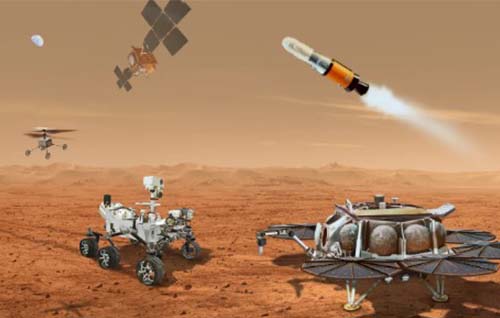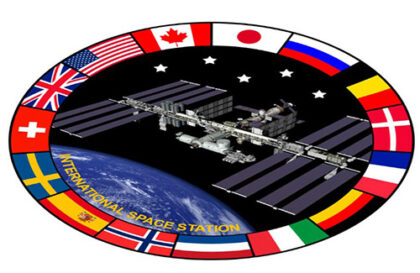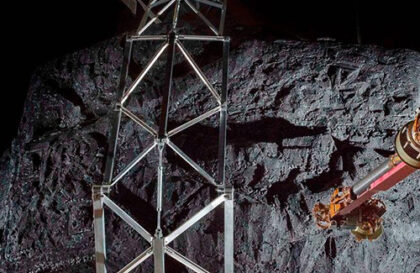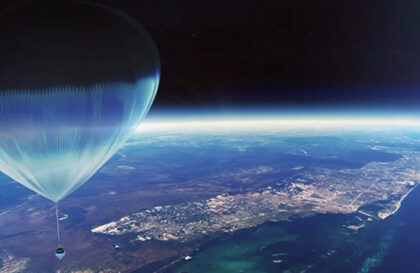In the 60s and 70s, the Soviet Union threw probes to Mars like Michael Jordan, throwing balls into a basket. Alas, the Soviet country’s efforts at that time were unsuccessful.
Mars 3 was the first to land successfully in 1971, but contact with it was lost soon after. Before him, more than ten Soviet apparatuses failed.
The US Viking landers reached the surface in 1976 and provided several years of images and data. After that, there were no successful landings on Mars until 1997, when Mars Pathfinder landed.
“Ares Vallis” as photographed by Mars Pathfinder. Credit: NASA/JPL
There have been several successful landings in the 21st century, but there have also been many accidents.
First attempts to launch to Mars
The first Soviet attempts to explore Mars began in 1960 with the launch of two Mars-1M spacecraft, each weighing about 650 kg. Both ships failed to reach orbit. In 1962, Mars 1 was launched, which, unfortunately, could not reach Mars. At the same time, two other Soviet vehicles, Mars 2MV-4 No. 1 and Mars 2MV-3 No. 1, each weighing 900 kg (2,000 lb), also encountered problems and were unable to leave Earth orbit. The first Soviet probe designed to land on the surface of Mars, Mars 1962B, was launched unsuccessfully in 1962.
In 1969, the USSR tried to launch two spacecraft Mars 2M No. 521 and Mars 2M No. 522, known in the West as Mars 1969A and B. These vehicles weighed 5 tons and on board one of them was a rover weighing 4.5 kg (9.9 pound), designed to move along the Martian surface.
These probes were launched by Proton-K rockets, but did not reach orbit due to the explosion of the launch vehicle. The cause of the explosion was a fire due to an unbalanced oxidizer turbopump rotor. The fragments of the rocket and probe fell on the territory of the Altai Mountains.
Mars 2 Lander model at the Memorial Museum of Cosmonautics in Russia. Credit: Wikipedia (public source).
Even more difficult for Soviet engineers was the news that Mariner 7 had been successfully launched from Cape Canaveral a few days earlier.
Mars 4NM and Mars 5NM
In 1970, the USSR began developing missions to Mars using new models of spacecraft – Mars 4NM and Mars 5NM. The rover was scheduled to depart for Mars in 1973, followed by a mission to return samples from the planet in 1975. The N1 rocket was planned to be used to launch these missions. However, due to problems with this missile, the projects were cancelled.
Mars-2 and Mars-3
In 1971, the American Mariner 9 mission flew to Mars and encountered an unexpectedly severe dust storm that obscured the entire surface of the planet. This storm was the largest ever recorded.
Next came Mars-2 and Mars-3, which, unable to adjust the mission, partially completed their tasks, despite the poor conditions. Their landers were sent to the planet. The Mars 2 lander failed to land and collided with Mars. The orbiters spent most of their data transmission capacity surveying dust clouds instead of exploring the surface.
Mars 3 Orbiter (nearly identical to Mars 2) with lander visible at top. Credit: Wikipedia (public source).
The Mars 3 module was the first to successfully land on Mars, but the data transfer was short-lived. 90 seconds after landing, data transmission began, which was interrupted after 14.5 seconds.
The probes sent back 60 images. Data from them showed mountains up to 22 kilometers (14 mi) high, atomic hydrogen and oxygen in the upper atmosphere, surface temperatures of -110 to 13 °C (-166 to 55 °F), surface pressure of 5.5 to 6 mbar (0.55 to 0.6 kPa), the concentration of water vapor is 5000 times less than in the Earth’s atmosphere, the base of the ionosphere begins at an altitude of 80 to 110 kilometers (50 to 68 mi) and dust storm particles at altitude up to 7 kilometers (4.3 mi) in the atmosphere.
Mars 2 and Mars 3 completed their missions by August 22, 1972, completing 362 orbits (Mars 3 completed 20 orbits). Both remained in Martian orbit.
Mars-6 and Mars-7
In 1973, the Soviet Union sent two more landers to Mars: Mars 6 and Mars 7.
Mars-6
In 1974, the Mars-6 module began its descent to Mars, separating from the orbital module at an altitude of 48,000 km. During its passage through the Martian atmosphere, the module’s speed decreased from 5600 m/s to 600 m/s. For further braking, a parachute was used, and the brake rockets were also supposed to be activated in the last seconds before landing. However, it seems that the last step was not completed successfully. Also, due to problems with the chip, most of the data transmitted by the module was unsuitable for analysis.
Mars-7
The Mars 7 probe separated prematurely from its carrier ship due to a problem in the operation of one of the onboard systems (attitude or retro-rockets) and flew past the planet by 1,300 km (810 miles).
Mars flyby/lander. Credit: Wikipedia (public source).
Mars Pathfinder
NASA’s Mars Pathfinder spacecraft successfully landed on Mars on July 4, 1997, supported by the Mars Global Surveyor orbiter. He settled in the Ares Vallis region, an ancient riverbed lowland in the north of the planet known for its rocky terrain. Pathfinder carried the small rover Sojourner, which became the first rover to successfully explore the surface of Mars. Sojourner moved through the area, examining the surrounding rocks and analyzing their composition. The research attracted worldwide attention, and photographs of the rover exploring the Martian surface were published in newspapers around the world.
Air bags for the Mars Pathfinder mission. Credit: NASA
Before completing its mission on September 27, 1997, Mars Pathfinder successfully transmitted a vast amount of data about Mars. The data included 16,500 images from the lander itself and 550 images from the Sojourner rover. In addition, the results of more than 15 chemical analyzes of Martian rocks and soil were obtained, as well as detailed meteorological data.
Results obtained from the scientific instruments on Mars Pathfinder indicated that conditions on Mars were much more hospitable in ancient times than they are today. This data supported the theory that Mars may have had liquid water in the past and a thicker atmosphere, making the planet potentially habitable.
Public interest in the Mars Pathfinder mission has been enormous. Her website, which featured regular updates and new images, became one of the most visited websites during this period.
Other failures
Mars 96, an orbiter launched by Russia on November 16, 1996, failed when the planned second launch of the fourth stage of the D-2 block did not occur.
Following the success of the Mars Global Surveyor and Mars Pathfinder missions, space exploration of Mars faced a series of setbacks in 1998 and 1999.
The Nozomi orbiter, which was launched by Japan, has encountered technical difficulties and equipment failures. It failed to reach its target orbit around Mars.
The Mars Climate Orbiter, launched by NASA, became famous for its failure caused by simple human error. An error occurred during his mission due to differences in units of measurement between NASA engineers and their Lockheed Martin contractors. While NASA used the metric system of measurement, Lockheed Martin engineers used traditional American units of measurement. This error led to incorrect calculations, causing the Mars Climate Orbiter to come too close to Mars and burn up upon entering its atmosphere.
Mars Polar Lander and the Deep Space 2 penetrators also faced their own sets of problems. The Mars Polar Lander lost contact during a landing attempt, and Deep Space 2, designed to penetrate the surface of Mars and study its soil, also failed to successfully complete its mission.
Banner image: NASA/JPL-Caltech
Image credit:
https://www.nasa.gov
https://www.nasa.gov
https://en.wikipedia.org
https://en.wikipedia.org
https://en.wikipedia.org
https://www.esa.int





